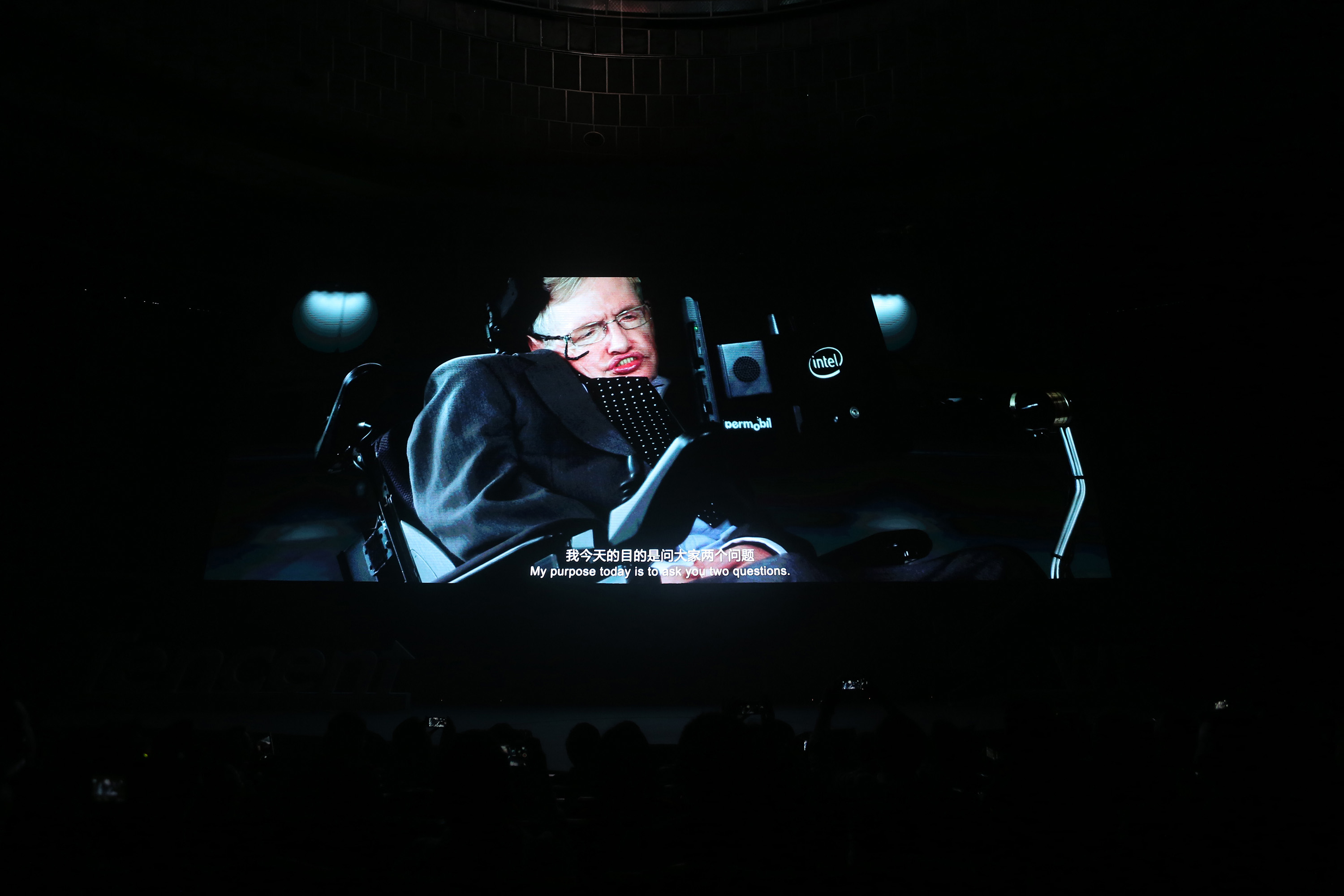
Stephen Hawking addressed the WE Summit. (Photo: People's Daily)
Beijing (People's Daily) - Stephen Hawking, the world-renowned theoretical physicist, cosmologist and professor at the University of Cambridge, addressed the Tencent WE Summit in Beijing, China on Nov. 5 through video, saying people should actively explore the universe and find another habitable planet.
The following is the full script of Stephen Hawking's address:
Hello Beijing. My name is Stephen Hawking. Welcome to the WE Summit.
I have been asked to address you today, on the role of earth and humans, in the context of the universe. I can best do this by reflecting on humanity's future, and examining the options for us to explore space for possible habitable planets. My purpose today is to ask you two questions. First, what it is that we need to do, to ensure that the future of mankind, achieves the highest level of near perfection as is humanly possible. And second, why should we be thinking about exploring other planets for possible habitation.
One reason is that the earth is becoming too small for us. In the last two hundred years the growth has become exponential, that is, the population grows by the same percentage each year. Currently the rate is about one point nine per cent a year. This may not sound very much, but it means that the world population doubles every forty years. I will celebrate my 80th birthday in 2022, and in my lifetime, the world’s population has quadrupled.
This exponential growth cannot continue into the next millennium. By the year 2600, the world's population would be standing shoulder to shoulder, and the electricity consumption would make the Earth glow red hot. This is untenable. But I am an optimist. I believe we can avoid this potential for Armageddon, and the best way for us to do this, is to move out into space, and explore the potential for humans to live on other planets.
But what would be the justification. Aren't there better causes here, on Earth. In a way, today’s situation is like that in Europe, before 1492. People might well have argued that it was a waste of money, to send Columbus on a wild goose chase. Yet the discovery of the New World, made a profound difference to the Old. It became a Utopia for the disenfranchised, when other options seemed closed. Spreading out into space will have an even greater effect. It will completely change the future of the human race, and maybe determine whether we have any future at all. It won't solve any of our immediate problems on planet Earth, but it will give us a new perspective on them, and cause us to look outwards rather than inwards. Hopefully, it would unite us, to face the common challenge.
What will we find when we go into space. Is there alien life out there, or are we alone in the universe. We believe that life arose spontaneously on the Earth, and evolved to be supremely compatible with the Earth’s resources. So it must be possible for life to appear on other suitable planets. But even if the possibility of life appearing on a suitable planet is very small, since the universe is infinite, we can assume that life would have appeared somewhere. If the probability is very low, the distance between two independent occurrences of life would be very large.
The Moon and Mars are the most obvious sites for space colonies in the solar system. Mercury and Venus are too hot, while Jupiter and Saturn are gas giants, with no solid surface. The moons of Mars are very small, and have no advantages over Mars itself. Some of the moons of Jupiter and Saturn might be possible. Europa, a moon of Jupiter, has a frozen ice surface. But there may be liquid water under the surface, in which life could have developed? How can we find out. Do we have to land on Europa, and drill a hole?

Pete Worden exhibited the prototype of the StarChip at the summit on November 5. (Photo: People's Daily)
Interstellar travel must be a long-term aim. And by long-term, I mean over the next two hundred to five hundred years.
However, there is an alternative. Last year I joined with the entrepreneur, Yuri Milner, to launch Breakthrough Star Shot, a long-term research and development program, aimed at making interstellar travel a reality. If we succeed, we will send a probe to Alpha Centauri, our closest star system to the Solar System, within the lifetime of some of you here today.
Breakthrough Star Shot is a real opportunity for man to make early forays into outer space, with a view to probing and weighing the possibilities of colonisation. It is a proof of concept mission, and works on three concepts: miniaturised space craft; light propulsion; and phase-locked lasers. The Star Chip, a fully functional space probe reduced to a few centimetres in size, will be attached to a light sail. Made from meta materials, the light sail weighs no more than a few grams. It is envisaged that a thousand Star Chips and light sails, the nano craft, will be sent into orbit. On the ground, an array of lasers will combine into a single very powerful light beam. The beam is fired through the atmosphere, striking the sails in space, with tens of gigawatts of power.
The idea behind this innovation, is that the nano craft ride on the light beam. Not quite to the speed of light, but to a fifth of it, or one hundred million miles an hour. Such a system could reach Mars in less than an hour, reach Pluto in days, pass Voyager in under a week, and reach Alpha Centauri in just over twenty years. Importantly, the Star Chips trajectories may include a fly-by of Proxima B, the earth-sized planet that is in the habitable zone of its host star, Alpha Centauri. Only this year, Breakthrough and the European Southern Observatory joined forces to further a search for habitable planets in Alpha Centauri.
So far, so possible. However, there are major challenges. A laser with a gigawatt of power, would provide only a few newtons of thrust. But the nano craft compensate for this, by having a mass of only a few grams. The engineering challenges are immense. The nano craft must survive extreme acceleration, cold, vacuum, and protons, as well as collisions with junk such as space dust. In addition, focusing a set of lasers totalling one hundred gigawatts on the solar sails, will be difficult due to atmospheric turbulence.
There are serious questions. How do we combine hundreds of lasers through the motion of the atmosphere, how do we propel the nano craft without incinerating them, and how do we aim them in the right direction? Then we would need to keep the nano craft functioning for twenty years in the frozen void, so they can send back signals across four light years. But these are engineering problems, and engineers challenges tend, eventually, to be solved. As it progresses into a mature technology, other exciting missions can be envisaged. And if Breakthrough Star Shot should send back images of a habitable planet orbiting our closest neighbour, it could be of immense importance to the future of humanity.
I hope I have attempted to answer the questions I set at the beginning of my talk. The human race has existed as a separate species for about two million years. Civilization began about ten thousand years ago, and the rate of development has been steadily increasing. If the human race is to continue for another million years, we will have to boldly go, where no one has gone before.
Thank you for listening.
The following is the Chinese version of Stephen Hawking's address:
你好,北京!我是史蒂芬•霍金。欢迎来到腾讯WE大会。
我今天的演讲,是关于在宇宙这一背景下,地球和人类所扮演的角色。为了最好地阐述,我需要从两个维度出发,一是思考人类的未来,二是研究我们探索太空、寻求其他潜在宜居星球的选择。我今天的目的,是问大家两个问题。首先,我们需要做什么才能够确保,在力所能及的范围内,人类的未来达到尽可能完美?其次,我们为什么要考虑探索其他宜居星球?
一个原因是,对我们来说,地球变得太小了。在过去二百年中,人口增长率是指数级的,即每年人口以相同比例增长。目前这一数值约为1.9%。 这听起来可能不是很多,但它意味着,每四十年世界人口就会翻一番。 2022年,我将庆祝自己80岁的生日,而在我人生的这段历程中,世界人口比我出生时膨胀了四倍。
这样的指数增长不能持续到下个千年。 到2600年,世界将拥挤得 “摩肩擦踵”,电力消耗将让地球变成“炽热”的火球。这是岌岌可危的。然而我是个乐观主义者,我相信我们可以避免这样的世界末日,而最好的方法就是移民到太空,探索人类在其他星球上生活的可能。
但是理由充分吗?难道留在地球上不是更好? 在某种程度上,今天的情况就如同1492年前的欧洲。当时的人们很可能坚信,哥伦布的探险注定是徒劳无功。 然而,新世界的发现,对旧世界带来了深远的影响。对于那些被剥夺权利地位、走投无路的人来说,新世界成为了他们的乌托邦。人类向太空的拓展,甚至将会产生更深远的影响,这将彻底改变人类的未来,甚至会决定我们是否还有未来。它不会解决地球上任何迫在眉睫的问题,但它将提供解决这些问题的全新视角,让我们着眼于更广的空间,而不是拘泥眼下。希望这能够让我们团结起来,面对共同的挑战。
当我们进入太空时,会有怎样的发现呢?会找到外星生命,还是发现我们终将在宇宙中踽踽独行?我们相信,生命在地球上是自然而生的,是在漫长的进化后,实现了与地球资源的高度契合。因此,在其他条件适宜的星球上,生命的存在也必定是可能的。即使这种可能性极小,但宇宙是无限的,我们还是可以假设,生命会在某处出现。不过,如果概率很低,那么出现生命的两个星球间的距离,可能将异常遥远。
在太阳系中,月球和火星是太空移民地最显而易见的选择。水星和金星太热,而木星和土星是巨大的气体星球,没有坚实的表面。火星的卫星非常小,并不比火星本身更优。木星和土星的一些卫星也存在可能。比如木星的卫星之一欧罗巴,它的表面是冰层,但其下可能会有液态水,也就可能会孕育生命。那么我们如何确定这种可能?是否必须登陆欧罗巴,然后钻一个洞?
星际航行必然是一个长期的目标。我所说的长期,是指未来二百到五百年。
但是,还有另一种选择。去年,我与企业家尤里•米尔纳(Yuri Milner)一起,推出了长期研发计划——“突破摄星”,目标是让星际旅行变成现实。如果成功,在座各位有些人的有生之年内,我们将向太阳系最近的星系——半人马座阿尔法星系发送一个探测器。
“突破摄星”是人类初步迈向外太空的真正机会,为了探索和考量移居太空的可能性。 这是一项概念验证的使命,其中涉及三个概念:迷你太空飞行器、 光动力推进和锁相激光器。“星芯片”是尺寸被缩小到仅几厘米、但功能完备的太空探测器,它将附着于“光帆”上。“光帆”由超材料制成,重量仅有几克。我们设想,一千个由 “星芯片”和 “光帆”组成的纳米飞行器将被送入轨道。 在地面上,激光器阵列将共同形成一道超强光束,光束穿过大气,以数十吉瓦的功率射向太空中的“光帆”。
这项创新背后的想法,是以光束来驱动纳米飞行器的前进。这样产生的速度虽然不及光速,但也能达到其五分之一,约合每小时1亿英里。这样的系统可以在一小时内抵达火星,几天内到达冥王星,一周内就可以追上并超过旅行者号探测器,并在仅二十年后到达半人马座阿尔法星系。重要的是,“星芯片”的轨迹可能包括“比邻星b”,这颗位于半人马座阿尔法星宜居带的行星,与地球的大小类似。正是在今年,“突破摄星”与欧洲南方天文台携手合作,进一步探寻半人马座阿尔法星系的宜居行星。
目前看来,这些都可能成为现实。但我们也看到重大的挑战。1吉瓦功率的激光器仅能提供几牛顿的推力,不过因为纳米飞行器只有几克重量,恰恰可以克服这个问题。但是工程方面的挑战是巨大的。纳米飞行器必须经受极限加速、极寒、真空和质子,以及与太空粉尘等垃圾的碰撞。另外,由于大气湍流,将一套总量100吉瓦功率的激光组瞄准太阳帆,也是很困难的事情。
还有一些严峻的问题。如何让数百道激光穿过大气波动时聚合,如何推动纳米飞行器又不烧毁它们,如何让它们瞄准正确的方向?此外,我们还需要让纳米飞行器在冰冷的真空环境中工作二十年,这样它们才能将信号传回到四光年外的地球。然而这些都是工程设计要解决的问题,而工程挑战往往最终都会被解决。随着技术进步日趋成熟,我们可以展望更多令人兴奋的使命。如果“突破摄星”计划能传回毗邻星系中宜居星球的图像,这对人类的未来必将产生深远影响。
希望我已经解答了我演讲一开始所提出的问题。人类作为独立的物种,已经存在了大约二百万年。我们的文明始于约一万年前,其发展一直在稳步加速。如果人类想要延续下一个一百万年,我们就必须大胆前行,涉足无前人所及之处!
感谢大家的聆听。


